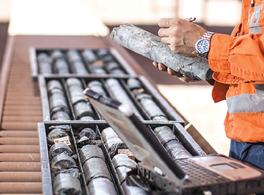OZ Minerals has increased the scope of an ongoing prefeasibility study of its Carrapateena underground copper-gold project in South Australia to include mine production of 4 million metric tons per year (mt/y), up from a previously considered 2.8 million mt/y. The study is also evaluating construction of a concentrate treatment plant at the port of Whyalla on the Spencer Gulf, about 200 km south of the Carrapateena project site.
As of early May, OZ was expecting to award a contract by the end of June for mining of a decline to access the Carrapateena orebody. By starting construction of the decline at this time, the company anticipates that the underground mine can begin generating operating cash flow in 2019.

Drilling is currently under way at Carrapateena to support a potential upgrade of the resource classification. (Photo: OZ Minerals)
Concentrates produced at the Carrapateena site will be transported to the Whyalla concentrate treatment plant for removal of deleterious elements, thereby improving marketability. The plant will also reduce the weight of the concentrate by up to 40%, dramatically reducing the cost of shipping and transport to customers.
Total preproduction capital expenditures for the Carrapateena mine and concentrator and the Whyalla plant are estimated at about A$975 million. Production during the first three years of operation is estimated at about 67,000 mt/y of copper and 76,000 oz/y of gold in concentrate.
“The larger Carrapateena project is very compelling,” OZ Managing Director and CEO Andrew Cole said. “With such strong financial metrics, we have decided to commence development of the mine’s decline and accelerate the prefeasibility study with a larger 4-million-mt/y scope, with the aim of first copper concentrate production in 2019.”
Recent prefeasibility study optimization work has addressed a number of risks and opportunities, allowing a more defined project. This work included:
- A sublevel cave dilution study that con firmed that dilution from the overburden does not pose a material risk to the ore grade. The deposit will cave appropri ately and the previously used dilution assumptions are valid.
- A conveyor study that determined that a conveyor capable of hauling the re quired tonnage can be installed withina single decline. The installation will allow for a rapid ramp-up of production, negate the need for a second decline or shaft, remove the need for haulage trucks, and reduce mine operating costs. The conveyor option also provides flexibility for future capacity increases.
A drilling program is currently under way at Carrapateena to collect samples for metallurgical test work and to support a potential upgrade of the resource classification.









